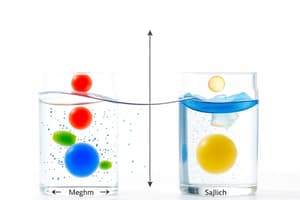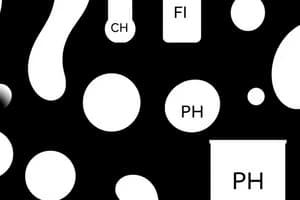Podcast
Questions and Answers
What primarily determines the acidity of a solution?
What primarily determines the acidity of a solution?
- The total number of hydrogen ions present, bound and unbound.
- The quantity of anions available in the solution.
- The number of water molecules in the solution.
- The concentration of free hydrogen ions in the solution. (correct)
Why is the regulation of blood pH considered particularly critical for human health?
Why is the regulation of blood pH considered particularly critical for human health?
- Blood pH directly affects bone density and strength.
- Blood is in contact with nearly every cell in the body. (correct)
- Blood pH affects the rate of muscle contraction.
- Blood is the primary fluid for nutrient storage.
Which range represents the normal blood pH in humans?
Which range represents the normal blood pH in humans?
- 6.0 to 8.0
- 7.0 to 7.8
- 6.85 to 7.25
- 7.35 to 7.45 (correct)
Under normal metabolic conditions, acids in the body are generated by which process?
Under normal metabolic conditions, acids in the body are generated by which process?
How do buffers function to resist changes in pH?
How do buffers function to resist changes in pH?
What happens in a buffered solution as the pH rises?
What happens in a buffered solution as the pH rises?
What distinguishes a strong acid from a weak acid?
What distinguishes a strong acid from a weak acid?
What does the pKa value represent?
What does the pKa value represent?
In understanding the pKa value, a lower pKa indicates what about the acid?
In understanding the pKa value, a lower pKa indicates what about the acid?
What does the Henderson-Hasselbalch equation allow you to determine?
What does the Henderson-Hasselbalch equation allow you to determine?
According to the Henderson-Hasselbalch equation, how is pH calculated?
According to the Henderson-Hasselbalch equation, how is pH calculated?
What makes a buffer most effective?
What makes a buffer most effective?
Why is buffering capacity optimal at the pKa?
Why is buffering capacity optimal at the pKa?
What will happen if you add H+ to a solution at its pKa?
What will happen if you add H+ to a solution at its pKa?
What happens if OH- is added to a solution that is at its pKa?
What happens if OH- is added to a solution that is at its pKa?
Which of the options is a physiologically important buffer system in the blood?
Which of the options is a physiologically important buffer system in the blood?
How does the Henderson-Hasselbalch equation assist in clinical diagnostics related to acid-base balance?
How does the Henderson-Hasselbalch equation assist in clinical diagnostics related to acid-base balance?
Which of the options correctly explains the role of hemoglobin as a buffer?
Which of the options correctly explains the role of hemoglobin as a buffer?
What characteristic feature of histidine makes hemoglobin an effective blood buffer?
What characteristic feature of histidine makes hemoglobin an effective blood buffer?
How does the pKa of histidine change within hemoglobin, and what causes this change?
How does the pKa of histidine change within hemoglobin, and what causes this change?
Which form of hemoglobin, oxyhemoglobin or deoxyhemoglobin, is a better buffer for hydrogen ions produced during metabolism, and why?
Which form of hemoglobin, oxyhemoglobin or deoxyhemoglobin, is a better buffer for hydrogen ions produced during metabolism, and why?
Given that the pH of blood is 7.4, the pKa of oxyhemoglobin is 6.8, and the pKa of deoxyhemoglobin is 7.8, what can be inferred using the Henderson-Hasselbalch equation?
Given that the pH of blood is 7.4, the pKa of oxyhemoglobin is 6.8, and the pKa of deoxyhemoglobin is 7.8, what can be inferred using the Henderson-Hasselbalch equation?
Based on the Henderson-Hasselbalch equation and given a pH of 7.4 and a pKa of 6.8 for oxyhemoglobin, what is the approximate ratio of base to acid for oxyhemoglobin?
Based on the Henderson-Hasselbalch equation and given a pH of 7.4 and a pKa of 6.8 for oxyhemoglobin, what is the approximate ratio of base to acid for oxyhemoglobin?
What is the percentage of water in infants?
What is the percentage of water in infants?
What percentage of water is found in healthy young men?
What percentage of water is found in healthy young men?
Which of the following is an example of a strong acid?
Which of the following is an example of a strong acid?
Which of the following statements is true about amino acids and their buffering capabilities?
Which of the following statements is true about amino acids and their buffering capabilities?
Why isn't the amino acid glycine a good candidate for physiological buffering?
Why isn't the amino acid glycine a good candidate for physiological buffering?
Why are the alpha carboxyl and alpha amino groups not good physiological buffers?
Why are the alpha carboxyl and alpha amino groups not good physiological buffers?
Which blood component acts as a chemical buffer?
Which blood component acts as a chemical buffer?
What is the approximate water percentage in the body mass of old age?
What is the approximate water percentage in the body mass of old age?
What happens to the pH of body fluids when buffers resist abrupt and large swings?
What happens to the pH of body fluids when buffers resist abrupt and large swings?
What is the pH of pure distilled water?
What is the pH of pure distilled water?
If the hydrogen ion concentration [H+] is 10-2 M, what is the pH?
If the hydrogen ion concentration [H+] is 10-2 M, what is the pH?
If the hydrogen ion concentration [H+] is 10-2, then what is the hydroxide ion concentration [OH-]?
If the hydrogen ion concentration [H+] is 10-2, then what is the hydroxide ion concentration [OH-]?
What is the general pH range that living organisms survive in?
What is the general pH range that living organisms survive in?
Which organs regulate acid-base balance?
Which organs regulate acid-base balance?
What is the pH of blood that is considered neutral?
What is the pH of blood that is considered neutral?
Flashcards
What is pH?
What is pH?
pH is a measure of hydrogen ion concentration in a solution, indicating acidity or alkalinity.
Normal blood pH
Normal blood pH
Blood pH is critical and normally ranges from 7.35 to 7.45.
Sources of acids in the body
Sources of acids in the body
Acids enter the body through foods; most are generated by protein breakdown, incomplete fat or glucose oxidation, and carbon dioxide transport.
Acid-base balance regulation
Acid-base balance regulation
Signup and view all the flashcards
How buffers work
How buffers work
Signup and view all the flashcards
Ionization of water
Ionization of water
Signup and view all the flashcards
pH calculation
pH calculation
Signup and view all the flashcards
Acids versus Bases
Acids versus Bases
Signup and view all the flashcards
What are strong acids?
What are strong acids?
Signup and view all the flashcards
Definition of pKa
Definition of pKa
Signup and view all the flashcards
Henderson-Hasselbalch Equation
Henderson-Hasselbalch Equation
Signup and view all the flashcards
Optimal buffering
Optimal buffering
Signup and view all the flashcards
Physiological buffers in blood
Physiological buffers in blood
Signup and view all the flashcards
H2CO3 proportion
H2CO3 proportion
Signup and view all the flashcards
Amino acids as buffers
Amino acids as buffers
Signup and view all the flashcards
Hemoglobin as a buffer
Hemoglobin as a buffer
Signup and view all the flashcards
pKa of oxyhemoglobin vs Deoxyhemoglobin
pKa of oxyhemoglobin vs Deoxyhemoglobin
Signup and view all the flashcards
Study Notes
- pH and buffering presented by Despo Papachristodoulou.
Learning Outcomes
- Explain the difference between strong and weak acids in terms of dissociation properties.
- Define and explain pKa and its importance in biological buffering.
- Use the Henderson-Hasselbalch equation.
- List a number of physiological buffers.
- Explain how proteins can be used as physiological buffers.
- Describe the function of Hemoglobin as a buffer for hydrogen ions produced in metabolism; explain what allows this to happen.
What is pH?
- pH measures hydrogen ion concentration, indicating the acidity or alkalinity of a solution.
- Acidity depends only on free hydrogen ions, not those bound to anions.
Blood pH
- Blood pH regulation is critical as blood contacts nearly every body cell.
- Normal blood pH range is very narrow: 7.35 to 7.45; pH levels outside these limits may be fatal.
- The living pH range extends from 7.0 to 7.8, with conditions including acidosis, normal range, and alkalosis.
Acids in the body
- Acids enter the body through foods.
- Acids are generated via breakdown of proteins, incomplete oxidation of fats or glucose, and loading and transport of carbon dioxide in the blood.
- Acid-base balance is regulated by the lungs, the kidneys, and chemical buffers.
Buffering
- Buffers resist abrupt and large pH swings in body fluids
- Buffers release H+ (acting as acids) when pH rises and bind H+ (acting as bases) when pH drops.
How buffers operate?
- Thorough understanding of a strong acid, strong base, weak acid, weak base, and ionization of water is important.
Ionization of water
- Pure water is a 55.6M solution
- Water dissociates to a very small extent: H₂O ↔ H+ + OH-
- [H+] x [OH-] = 10-14 M², which is the ionic product of water and the neutrality, where [H+] = [OH-] = 10-7M
pH Calculation
- pH = -log[H+]
- When [H+] = 10-2M, pH = 2
- At neutrality, where [H+] = [OH-], [H+] = 10-7M, so pH = -log[10-7] = -(-7) = 7
- When [H+] is 10-2, [OH-] is 10-12, and when [H+] is 10-4, [OH-] is 10-10
- Logarithmic values: 10^1 = 10 (log = 1), 10^2 = 100 (log = 2), 10^-2 = 1/100 (log = -2)
- Blood pH is 7.4
- pH calculation: 7.4 = -log[H+]; therefore, [H+] = 3.98 x 10^-8 M
Dissociation of Acids
- Acids are proton (H+) donors, while bases are proton acceptors.
- Strong acids dissociate completely whereas weak acids dissociate incompletely, depending on pH.
- Strong bases are more effective proton acceptors than weak ones.
pKa Explanation
- pKa equals -log Ka, with Ka representing the acid dissociation constant.
- It defines the pH at which an acid is half-dissociated and has equal amounts of undissociated acid and its conjugate base.
- A lower pKa signifies a stronger acid.
- At the pKA: Equal amounts of conjugate base and acid exist, essential for a mixture of weak acids and their conjugate bases to buffer solutions
- Buffering is the ability of a solution to resist pH change upon acid or alkali addition.
- Buffering is most effective at the pKa, where dissociated and non-dissociated forms of the acid (conjugate base and acid) are equal.
How pKa relates to buffering
- If H+ ions are added, conjugate bases pick them up.
- If OH- ions are added, acids donate protons to form H₂O.
- pH remains stable.
- Knowing the pKa of an acid indicates its best buffering pH.
Henderson-Hasselbalch equation
- pH = pKa + log([conjugate base]/[acid])
- Relates pH of a solution to pKa of weak acid and relative amounts of dissociated/non-dissociated forms.
Physiologically Important Buffers
- In blood, saliva, and other body fluids, H₂CO₃↔HCO₃- has a pKa of 6.1.
- H₂PO₄-↔HPO₄²- has a pKa of 6.8.
Henderson-Hasselbalch Equation Application
- (H₂CO₃↔HCO₃-) pKa 6.1
- H₂CO₃ is proportional to pCO₂
- Henderson-Hasselbalch equation may distinguish acidosis causes like metabolic or respiratory issues.
Amino Acids as Buffers
- Amino acids can be used as buffers
- Glycine titration with strong base is the reaction
- Acids present -COOH and -NH3+
- -COOH is the stronger acid, with a pKa of 2.34
- NH3+ is the weaker acid, with a pKa of 9.66
- Best buffering occurs around the two pKa values.
- There is no buffering by the zwitterion.
- Glycine isn't a good candidate for this because it buffers best at pH 2.3 and 9.6.
Haemoglobin's buffering
- Haemoglobin acts as a crucial blood buffer.
- Most amino acid side chains do not buffer within the physiological range.
- A large number of histidine residues contributes to haemoglobin's effectiveness.
- The pKa of histidine in Hb differs from free histidine (6), as neighboring groups affect the pKa.
- Oxyhemoglobin pKa = 6.8, and Deoxyhemoglobin pKa = 7.8.
- Which form of haemoglobin, oxyhemoglobin or deoxyhemoglobin, serves as a better buffer for H+ ions produced in metabolism? The answer depends on which is better able to pick up and carry H ions at the pH of blood. In order to know this, think pKa. What does it mean if the pH of blood is higher or lower than the pKa of Hb? Which form of it would be better able to carry the H ions?
- Hb carries oxygen to cells and carbon dioxide and picks up H ions produced in metabolism
- The different pKas of oxy and deoxy Hb mean that they are protonated to a different degree at the pH of blood
Henderson Hasselbalch equation
- pH of blood is 7.4
- pKa oxyHb 6.8
- pKa deoxyHb 7.8
- OxyHb: 7.4 = 6.8 + 0.6
- Log of base / acid is 0.6
- The ratio of base / acid is 3.98 : 1
- DeoxyHb: 7.4 = 7.8 - 0.4
- Log of base / acid is -0.4
- The ratio of base / acid is 1: 2.51
Free Diffusion & Biological Membranes
- Lipid soluble molecules can diffuse freely across biological membranes
- Substances that interact strongly with water cannot.
- Aspirin diffuses more easily at pH 2 rather than pH 7
Studying That Suits You
Use AI to generate personalized quizzes and flashcards to suit your learning preferences.



